HITLER APPEALS TO ARMY TO SAVE CAPITAL
Berlin, Germany · April 23, 1945
On this date in 1945, with most land communications and electrical power lines down, Adolf Hitler broadcast on Greater German Radio the order to save his beleaguered capital. The order called for Wehrmacht forces opposing the Americans at the Elbe River to withdraw and move north to rescue Berlin, a city of four million inhabitants, now within range of incessant Soviet artillery and Katyusha (“Little Katie”) truck-mounted rocket fire. Two days later Hitler assured Gen. Helmuth Weidling, newly appointed commander of “Fortress Berlin” and a veteran of campaigns in Poland, France, and the Soviet Union, that reinforcements from Gen. Theodor Busse’s Ninth Army, which basically consisted of repeatedly decimated and cobbled-together army units, and Gen. Walther Wenck’s recently formed Twelfth Army—90 percent of them 17- and 18‑year-old trainees, less than half of whom had weapons—would join forces to deliver a crushing blow to the “Jewish-Bolshevik enemy.”
Hitler’s talk was pure fantasy and Wenck and Busse knew that. Only the night before Field Marshal Wilhelm Keitel, chief of the Supreme High Command of the German Armed Forces (OKW), had surprised Wenck at his headquarters, 50 miles west of Berlin. Keitel told the 43‑year-old Wenck—the youngest man in the Wehrmacht to hold a general’s rank—that he and Busse must “liberate Berlin” by turning all their available forces around and linking them up. “Get the Fuehrer out. Wenck, you’re the only one who can save Germany!” Wenck knew it would be a waste of breath to try to talk sense into the agitated and delusional Keitel. He and Busse had nowhere near the resources to accomplish much of anything. (Wenck, for example, had not a single tank and almost no antiaircraft guns against Soviet aircraft. Busse’s Ninth Army had been reduced from its original complement of 200,000 men to 25,000, and none of his vehicles had gas.) In radiotelephone silence and numb resignation that Hitler’s war had run its course, the two generals gathered up the exhausted fragments of their battered and bruised armies and, joining tens of thousands of careworn civilians, retreated westward across the Elbe River, surrendering to the Americans on May 7, 1945.
Meanwhile, back in the Berlin cauldron, the number of troops from various branches of the armed services available to poor Weidling totaled around 80,000, barely enough to man the outer defense perimeter. Moreover about half of the capital’s defenders consisted of the untested Volkssturm people’s militia, city police, a motley, sometimes dragooned cadre of dejected teenagers, impatient Hitler Youths, and the elderly, many of whom—like Gen. Wenck’s boy soldiers—lacked sufficient weapons, ammunition, antitank trench-digging tools, and even basic training. The remainder consisted of exhausted, filthy, bearded, bloodshot-eyed and demoralized veterans of combat on the Eastern Front. Many of Weidling’s troopers had not even seen their rations of processed cheese and hard bread in a week. Ranged against these makeshift and half-starved formations were over 1.5 million battle-hardened, well-equipped, and well-fed Soviet soldiers.
On April 26 the capital’s defenders withdrew to within a few miles of Hitler’s underground bunker. The next day the German defense area shrank to less than 30 sq. miles. Hitler’s bunker was almost within spitting distance of the Soviets. (Actually, 170–250 ft away.) On the night of April 29/30, a frantic Hitler, still hoping to be rescued, demanded that Keitel tell him where Armee Wenck was. In his cramped living room hours later Hitler put a bullet through his right temple after biting down on a cyanide capsule. His wife Eva lay slumped on the small blue-and-white couch to his left, a suicide too. Above ground nothing remained of their Thousand Year Reich.
![]()
Scenes of Devastation from the Battle in Berlin, April 23–May 2, 1945
 | 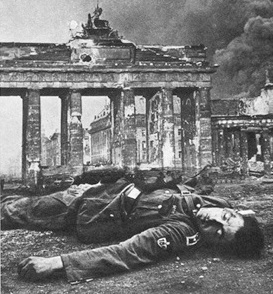 |
Left: Transformed into a fortress, the German Reichstag shows the scars of battle. Initially 5,000 strong, the forces defending the Nazi symbol of power included naval, SS, and Hitler Youth personnel armed with grenades, pistols, machine guns, and single-shot antitank Panzerfausts. Many defenders held out in the parliament building’s upper floors and cellars. It took hours of vicious room-to-room, often hand-to-hand fighting before Red Army soldiers secured the building. When the defenders called it quits, some 300 disheveled Germans spilled up the cellar steps, hands raised. Close to 200 lay in shattered rooms and halls where they had been killed, and 500 wounded filled the nearby first-aid station.
![]()
Right: A dead NCO, in a final act of allegiance, lies close to the mutilated Brandenburg Gate while smoke rises from the ruins of the nearby Reichstag. A Soviet bomber pilot who flew over Berlin at the end of April described how “smoke rose up to the sky like thousands of chimneys.” Normally he would have dropped his payload from 13,000 ft, but he had to descend to 5,000 ft to even see a target. Death, devastation, and smoke cast a pall over the Reich metropolis that lasted for weeks.
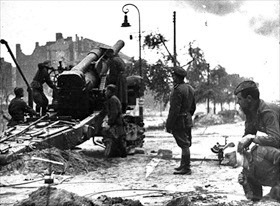 | 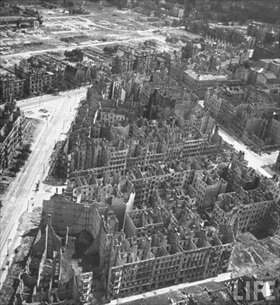 |
Left: Forty thousand Soviet artillery guns hammered the Nazi capital around the clock, sometimes setting entire streets ablaze and creating myriad paths of rubble and ruin over which hung acrid fumes from burning buildings and the stench of burnt flesh and putrefaction. The caliber of guns the Soviets brought to bear on Berlin’s neighborhoods increased rapidly. Capable of firing one shell every two minutes, 203mm howitzers like this one had a range of 10 miles and a crew of 15. Many civilians were killed by artillery fire as they cowered in cellars, attics, and other hiding places.
![]()
Right: An aerial photo of Berlin shows the legacy of destruction left by the war. By April 1945 much of Berlin, whose total area was almost 350 sq. miles, had become a moonscape of ruined buildings and cratered streets. A Soviet staff sergeant wrote: “The battles for Berlin were characterized by particular toughness and resistance on the part of the Germans. . . . The enemy refused to give up an inch of land without a fight. . . . On 22 April 1945 our battalion fought fierce street battles inside the city. . . . Everything was on fire. We spared nothing, and no ammunition, just to advance another few metres.” Quoted in Walter Kempowski, Swansong, p. 281.
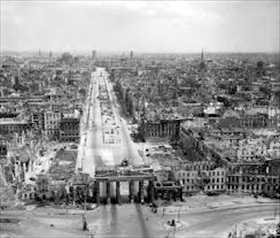 | 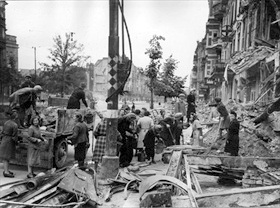 |
Left: Berlin’s premier street Unter den Linden in 1945 presented a grim contrast with the street’s prewar splendor. View is to the east.
![]()
Right: A Berlin street lined with 19th- and 20th-century apartment blocks is choked with debris. Berliners had learned to clear streets following Allied bombing raids in the early days of the war. During the Battle in Berlin (end phase of the Battle of Berlin), streets and sidewalks like the one pictured here were turned into rubble-fields and thousands of citizens were conscripted afterwards to make them passable.
Battle in Berlin 1945: A Cavalcade of Photos from German and Soviet Archives
![]()

 History buffs, there is good news! The Daily Chronicles of World War II is now available as an ebook for $4.99 on Amazon.com. Containing a year’s worth of dated entries from this website, the ebook brings the story of this tumultuous era to life in a compelling, authoritative, and succinct manner. Featuring inventive navigation aids, the ebook enables readers to instantly move forward or backward by month and date to different dated entries. Simple and elegant! Click
History buffs, there is good news! The Daily Chronicles of World War II is now available as an ebook for $4.99 on Amazon.com. Containing a year’s worth of dated entries from this website, the ebook brings the story of this tumultuous era to life in a compelling, authoritative, and succinct manner. Featuring inventive navigation aids, the ebook enables readers to instantly move forward or backward by month and date to different dated entries. Simple and elegant! Click 











